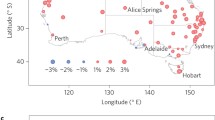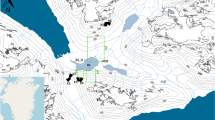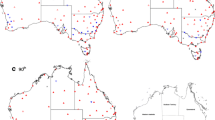Abstract
Creation of ice layers in snow due to thaw-refreeze events can lock away winter forage, preventing access by large mammals and causing population declines. Data are limited, however, on the frequency, timing, extent, and size of thaw-refreeze events in northern latitudes given the area’s remoteness and paucity of weather stations. We used a remote sensing approach to detect thaw-refreeze events in Alaska during winter between 2001 and 2008. We also compared these results to a regional climate reanalysis dataset that identified rain events (freezing and non-freezing rain). All areas of the state, except high elevation sites, had ≥1 thaw-refreeze event during the study period. Southwestern Alaska had the highest frequency of thaw-refreeze events with an average of >4 events each winter, whereas northern Alaska had the lowest frequency with an average of <2 events. We observed substantial inter-annual variation in the distribution and frequency of thaw-refreeze events. For most of the state, thaw-refreeze occurred at similar rates each winter month, except in northern Alaska where thaw-refreeze events were most frequent in early and later winter. The median extent of individual thaw-refreeze events was 469 km2, however, events in the interior of the state tended to be larger. Remotely sensed thaw-refreeze detections generally had low correspondence with observations from the climate reanalysis dataset. Our results support the use of remotely sensed data to identify thaw-refreeze events.






Similar content being viewed by others
References
Bartsch A, Kumpula T, Forbes BC, Stammler F (2010a) Detection of snow surface thawing and refreezing in the Eurasian Arctic with QuikSCAT: implications for reindeer herding. Ecol Appl 20:2346–2358
Bartsch A, Wagner W, Naeimi V (2010b) The legacy of 10 years of QuikSCAT land applications—possibilities and limitations for a continuation with Metop ASCAT. In: Lacoste-Francis H (ed) Proceedings of the ESA living planet symposium, Bergen, Norway. ESTEC, Noordwijk, pp 1–6
Collins WB, Smith TS (1991) Effects of wind-hardened snow on foraging by reindeer (Rangifer tarandus). Arctic 44:217–222
Fleming MD, Chapin FS III, Cramer W, Huffords GL, Serreze MC (2000) Geographic patterns and dynamics of Alaskan climate interpolated from a sparse station record. Glob Change Biol. doi:10.1046/j.1365-2486.2000.06008.x
Forchhammer M, Boertmann D (1993) The muskoxen Ovibos moschatus in north and northeast Greenland: population trends and the influence of abiotic parameters on population dynamics. Ecography 16:299–308
Grenfell TC, Putkonen J (2008) A method for the detection of the severe rain-on-snow event on Banks Island, October 2003, using passive microwave remote sensing. Water Resour Res. doi:10.1029/2007WR005929
Hansen BB, Aanes R, Sæther B-E (2010) Feeding-crater selection by high-arctic reindeer facing ice-blocked pastures. Can J Zool 88:170–177
Hansen BB, Aanes R, Herfindal I, Kohler J, Sæther B-E (2011) Climate, icing, and wild arctic reindeer: past relationships and future prospects. Ecology 92:1917–1923
Kidd RA, Trommler M, Wagner W (2003) The development of a processing environment for time-series analysis of SeaWinds Scatterometer data. IEEE Geosci Remote Sens 6:4110–4112
Liston GE, Hiemstra CA (2011) The changing cryosphere: pan-arctic snow trends (1979–2009). J Clim 24:5691–5712
Manikin GS, Brill KF, Ferrier B (2004) An ETA model precipitation type mini-ensemble for winter weather forecasting. In: 16th conference on numerical weather prediction. American Meteorological Society, Seattle. http://ams.confex.com/ams/pdfpapers/73517.pdf. Accessed 3 July 2012
Mesinger F et al (2006) North American regional reanalysis. Bull Am Meteorl Soc 87:343–360
Miller FL, Gunn A (2003) Catastrophic die-off of Peary Caribou on the Western Queen Elizabeth Islands, Canadian High Arctic. Arctic 56:381–390
Putkonen J, Roe G (2003) Rain-on-snow events impact soil temperatures and affect ungulate survival. Geophys Res Lett. doi:10.1029/2002GL016326
Rennert KJ, Roe G, Putkonen J, Bitz CM (2009) Soil thermal and ecological impacts of rain on snow events in the circumpolar arctic. J Clim 22:2302–2315
Shulski M, Wendler G (2007) The climate of Alaska. University of Alaska Press, Fairbanks
Solberg EJ, Jorhøy P, Strand O, Aanes R, Loison A, Sæther B-E, Linnell JDC (2001) Effects of density-dependence and climate on the dynamics of a Svalbard reindeer population. Ecography 24:441–451
Stien A, Loe LE, Mysterud A, Sverinsen T, Kohler J, Langvatn R (2010) Icing events trigger range displacement in a high-arctic ungulate. Ecology 91:915–920
Tyler NJC (2010) Climate, snow, ice, crashes, and declines in populations of reindeer and caribou (Rangifer tarandus L.). Ecol Monogr 80:197–219
VanDerWal J, Falconi L, Januchowski S, Shoo L, Storlie C (2012) Species distribution modelling tools: tools for processing data associated with species distribution modelling exercises (version 1.1-5). http://cran.R-project.Org/. Accessed 3 July 2012
Acknowledgments
This study was funded by the Western Alaska Landscape Conservation Cooperative. We thank S. McAffee, M. Cornelison, J. Dau, and B. Griffith for providing valuable comments on an earlier version of this manuscript.
Author information
Authors and Affiliations
Corresponding author
Rights and permissions
About this article
Cite this article
Wilson, R.R., Bartsch, A., Joly, K. et al. Frequency, timing, extent, and size of winter thaw-refreeze events in Alaska 2001–2008 detected by remotely sensed microwave backscatter data. Polar Biol 36, 419–426 (2013). https://doi.org/10.1007/s00300-012-1272-6
Received:
Revised:
Accepted:
Published:
Issue Date:
DOI: https://doi.org/10.1007/s00300-012-1272-6




